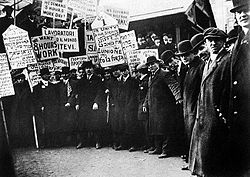Newspapers
The first Russian-language newspaper in the United States, Svoboda (Freedom), was published in 1867–1871; it was known as the Alaska Herald in English. Dozens of short-lived Russian newspapers were published until 1940.Russkaya Reklama (Russian Advertisement) weekly, founded in 1993 in Brooklyn, New York, is the largest Russian-language newspaper in the US, with a circulation of over 100,000. [17] It consists of yellow pages with classified ads.
Novoe russkoe slovo (The New Russian Word), published since 1910, was the longest published Russian daily newspaper until 2009, when it went weekly. [18] In the 1920s, it stopped being communist and pursued the wider audience of the Russian diaspora. [19] Its 1918-2001 archive is available for digital access at the National Library of Finland. [20]
Two years later, in 2011, the only Russian-language daily, the Reporter [21] (Репортер), began to be published in New York. [18]
Vecherniy New York [22] (The Evening New York) serves Tri-State area Russian-speakers, and Panorama, published since 1980, serves the Russian-speakers of the Greater Los Angeles area.
Kstati Russian American Newspaper (To the Point) serves the Bay Area.V Novom Svete (In the New World) covers mostly international news and is circulated nationwide, [18] while Evreiskii Mir (The Jewish World) is targeted at Russian-speaking Jews.
Television
Some Russian television stations in the United States include NTV, Russkii Mir (Russian World), RTR Planeta, RT News, RTVI, Channel One, Channel 9 (Israel). However, as of the beginning of the military actions by Russia, all Russian broadcasting on cable and satellite had been dropped temporarily. After a week of no broadcasting any Russian Television due to mounting public pressure from the Russian Speaking community TV providers restored access to both RTVI and RTN which were based in NYC. Some access to Russian State Media channels is still possible through the Internet/streaming.



